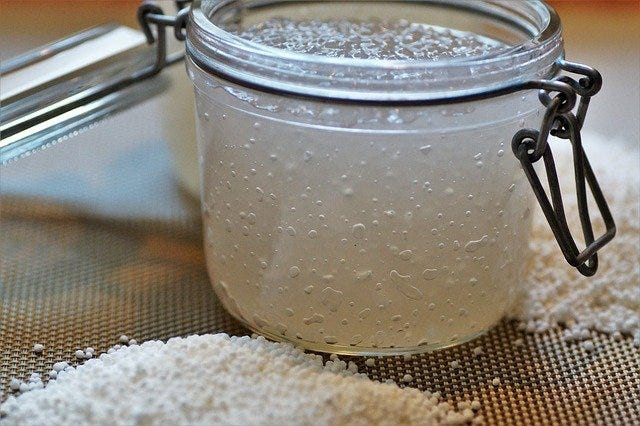Keep the water in your kava under 140°F/60°C

Today’s discussion centers on the starch content in kava, a popular beverage made from the roots of the Piper methysticum plant, and how this starch content plays a role in the gelatinization process when the temperature exceeds the solubility point of starch. This topic is not only intriguing but also vital for those who enjoy preparing and consuming kava.
A common guideline in kava preparation is to avoid heating it above 98.6 °F, with the most acceptable temperature being room temperature [1]. Temperatures approaching 140 °F cause denaturing of starch and should never be exceeded in kava preparation. This guideline has been passed down through generations and is often considered a golden rule in kava preparation. Initially, this temperature limit was thought to prevent the degradation of kavalactones, the active compounds in kava responsible for its psychoactive effects. However, recent studies and understanding have debunked this belief.
Kavalactones have a melting point ranging from 248°F (120°C) to 284°F (140°C), and their boiling point is even higher, around a theoretical 850°F (~450°C). These temperatures are well above the traditional preparation temperatures for kava. What this information reveals is that kavalactones are unlikely to be destroyed when heating kava, even at temperatures significantly higher than 140°F (60°C). This realization has led to a reevaluation of the traditional wisdom surrounding kava preparation and has prompted further investigation into the reasons behind the temperature guideline.
So, what’s the reason for keeping the temperature below 140°F (60°C)? The answer lies in the starch content of kava. Dried kava rootstock is composed of approximately 43% starch, a percentage that can vary depending on the plant’s age and cultivar [2]. Starch is a complex carbohydrate that plays a significant role in the texture or body of the prepared kava drink. Kavas higher in starch amounts will tend to make a smoother, creamier, and thicker beverage, enhancing the overall drinking experience.
Under normal, unheated conditions, starch doesn’t dissolve in water, so it rarely causes problems in kava preparation. However, starch has a specific temperature range where it begins to absorb water and dissolve in the presence of heat. This temperature falls within the 140°F (60°C) – 203°F (95°C) range [3]. This phenomenon, known as “starch gelatinization,” causes the starch to break down and act as a binding agent in water [4]. The process of gelatinization alters the molecular structure of the starch, leading to changes in its properties.
Cold water at 77°F (25°C) dissolves only about 4% of native starch, but this solubility increases to approximately 23% at 95°F (35°C) [5]. This increase in solubility is a clear indication of how temperature can affect the behavior of starch in a liquid medium. When raw starch is heated in water, the semicrystalline nature of its structure is reduced or eliminated, and the starch granules break down, forming a viscous solution [6]. This transformation can significantly alter the texture and consistency of the kava drink.
To avoid this gelatinization when making kava, it’s advisable to use water at room temperature or slightly warm, ensuring it stays under 140°F (60°C). This practice preserves the integrity of the starch and maintains the desired texture of the beverage. By understanding the science behind starch gelatinization and the temperature sensitivity of kava preparation, enthusiasts can optimize their brewing process to create the perfect cup of kava.
In conclusion, the traditional guideline to keep kava preparation below 140°F (60°C) is not about preserving kavalactones but rather about controlling the starch content’s behavior. The insights gained from studying this aspect of kava preparation open new doors for experimentation and refinement in brewing techniques, contributing to the rich cultural tradition surrounding this unique beverage.
[1] Gau, Loren D., Rachel Li, and H. C. Bittenbender. n.d. “Preparing Kava: Optimizing Kavalactone Extraction in Water.”
[2] Fu, Peter P et al. “Toxicity of kava kava.” Journal of environmental science and health. Part C, Environmental carcinogenesis & ecotoxicology reviews vol. 26,1 (2008): 89-112. doi:10.1080/10590500801907407
[3] Lumdubwong, Namfone. “Applications of Starch-Based Films in Food Packaging.” Reference Module in Food Science, Elsevier, 2019. ScienceDirect, doi:10.1016/B978-0-08-100596-5.22481-5.
[4] Wang, Shujun, and Les Copeland. 2013. “Molecular Disassembly of Starch Granules during Gelatinization and Its Effect on Starch Digestibility: A Review.” Food & Function 4 (11): 1564–80. https://doi.org/10.1039/c3fo60258c.
[5] Jivan, Mehdi Jalali et al. “Preparation of cold water-soluble potato starch and its characterization.” Journal of food science and technology vol. 51,3 (2014): 601-5. doi:10.1007/s13197-013-1200-y
[6] Ratnayake WS, Jackson DS. Starch gelatinization. Adv Food Nutr Res. 2009;55:221-68. doi: 10.1016/S1043-4526(08)00405-1. PMID: 18772106.



